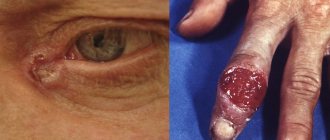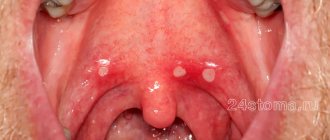Enlarged tonsils in a child are not a disease, but a symptom that signals pathological changes occurring in the young body. As practice shows, parents go to the doctor only if the baby’s body temperature increases, since it is believed that temperature is the only significant signal indicating that the child is sick. And this is a big mistake. The condition when one tonsil is larger than the other, or both are enlarged at once, can occur without fever or sore throat. And it also requires increased attention from parents.
Why do tonsils get enlarged? Tonsils are special organs of the immune system in the human nasopharynx. They consist of lymphoid tissue, protect the body from pathogens and prevent their further spread. The leading role in the body belongs to the palatine tonsils, or tonsils. The tonsils are located on the sides of the pharynx and meet infection that has entered through inhaled air or food. As soon as viruses and bacteria come into contact with the surface of the tonsils, the child's tonsils enlarge. At this time, there is an increased production of leukocytes - cells that attack and destroy the infection. When an enemy is defeated, the tonsils return to their original size. In other words, the large size of the palatine tonsils indicates that they are fighting pathogenic microflora.
But even when the tonsils are in a healthy state, it is important not to lose vigilance: normally, every person has bacteria on their mucous membranes that do not manifest themselves in any way, but under the influence of favorable conditions, they begin to multiply, provoking hypertrophy of the tonsils. These reasons for enlarged tonsils in children include:
- hypothermia;
- allergic reactions;
- deviated nasal septum;
- chronic diseases of the ENT organs;
- too dry air;
- living in a place with an unfavorable environment.
The concept of “loose tonsils”
The tonsils or tonsils are located behind the palatine arches and create a protective barrier against bacteria and germs. In normal condition they are almost invisible. If the inflammatory process develops, they begin to increase in size and become swollen and convex.
This occurs due to inflammation of the lymphoid tissue, which is the first to encounter the harmful effects of pathogenic microorganisms.
Loose tonsils can occur in the following cases:
- the beginning of the acute phase of the disease (ARVI, tonsillitis, pharyngitis and other diseases);
- chronic form of throat diseases;
- as a residual phenomenon after severe infectious diseases (angina, scarlet fever and others).
Loose tonsils require some care, as food debris gets stuck in them, which is an excellent flora for the proliferation of bacteria and the development of inflammatory processes.
Symptoms of chronic adenoiditis and adenoid hypertrophy
- Frequent lingering runny nose
- Nasal congestion, up to complete absence of nasal breathing
- As a result of the previous symptom, the child often breathes with his mouth open during the day or during sleep
- Cough, including dry cough at night (due to mucus draining down the back of the throat)
- Snoring while sleeping
- Decreased attention and fatigue due to lack of oxygen through nasal breathing
Is it possible to “give up” on these symptoms?
Even the uncomplicated form of chronic adenoiditis cannot be ignored; oxygen starvation, which develops against the background of difficulty in nasal breathing or breathing through the mouth, is manifested by a decrease in memory, perseverance, attention, and learning ability. The child becomes irritable, capricious, and gets tired quickly. The immune system is under constant stress of chronic inflammation, as a result of which a symptom of natural immunodeficiency appears, due to the depletion of the cellular elements of the immune system, and the child becomes weakened and often ill. With a large degree of hypertrophy, the facial skeleton may change, the so-called “adenoid” type of face is formed with an elongated lower part of the skeleton, a change in the bite, and a slightly open mouth.
In addition, we are afraid of the formation of complications
Complications of chronic adenoiditis and adenoid hypertrophy:
- Acute otitis media
- Exudative otitis (so-called “silent” otitis, when in the absence of pain hearing loss occurs due to the accumulation of fluid behind the eardrum)
- Persistent conductive hearing loss
- Frequent sore throats
- Tracheitis, bronchitis
- Sinusitis, ethmoiditis, sinusitis
Main causes
If you notice loose tonsils in a child, which clearly stand out with their rounded shapes, you should not panic and buy all the pharmaceutical drugs intended for the treatment of throat diseases. This condition indicates the onset of the development of the inflammatory process.
The tonsils began to form local protection so that the pathogenic microbes that got on them did not penetrate further into the body.
Interesting: in young children, the tonsils produce special enzymes that help break down food in the mouth.
The main culprit of looseness is a change in the functioning of the gland on the tonsils. In certain cases, the tonsils cannot cope with the effects of external infections. To fight microbes, a large number of lymphocytes are produced, but they are not always enough. As a result, painful processes begin to develop in the throat and nasopharynx.
There are several main reasons for the appearance of loose tonsils.
Entry of pathogenic viruses or bacteria into the oral cavity and nasopharynx. The production of plasmacides, microphages and lymphocytes begins in the follicles and lacunae. If the immune defense fails, the development of diseases such as tonsillitis, pharyngitis and others begins.
A decrease in the child’s immunity after suffering from infectious diseases as a result of the glands on the tonsils does not work correctly and the tonsils remain voluminous and loose.
Severe hypothermia or cold.
A residual phenomenon after suffering from acute respiratory viral infections or acute respiratory infections.
The presence of chronic diseases in the oral cavity (carious tooth decay, periodontitis, long-lasting wounds, etc.). The lymphatic system has to regularly suppress pathogenic microflora, which results in swelling of the tonsils.
In the case of frequent severe throat diseases, especially sore throats, damage to the lymphoid tissue begins as a result of which the mucous surface of the tonsils remains deformed forever.
Symptoms
Loose tonsils are a consequence of the development of the inflammatory process as a result of a variety of reasons. This in itself is not a disease, but its manifestation. Doctors do not diagnose “loose throat” - this is a visual manifestation of a concomitant illness. In addition, the following signs of the disease can be observed:
- Painful sensations when swallowing food and liquid.
- Deviation of body temperature from normal. In this case, the temperature can be either very high or not exceed the threshold of 37.3 degrees.
- Headache as a result of the toxicological effects of the breakdown of waste products of pathogenic microorganisms.
- General malaise. Lethargy, fatigue, weakness, body aches are a consequence of the development of infectious processes in the body.
- Hoarse voice. Appears after infection penetrates the vocal cords.
- Painful sensations and enlargement of the submandibular and cervical lymph nodes.
- External changes. Red throat, pronounced vascular network, protruding palatine tonsils, rashes on the tonsils, larynx and palate.
And also an unpleasant smell. In the absence of dental problems, this smell indicates the process of decomposition of lumps of food stuck on the surface of the tonsils. If food debris is not removed in time, inflammation of the lymphoid tissue is guaranteed.
Do not assume that such signs can appear at the same time. The presence of an inflammatory process in lymphoid tissue may be indicated by the presence of one or two symptoms.
Many dangerous and insidious throat diseases are difficult to recognize. Self-medication can lead to serious consequences for the body, as well as the development of chronic diseases.
What are adenoids?
Adenoids are three of the six lymphoid formations (tonsils) of the so-called lymphoid “Pirogov’s ring”: two tubal tonsils (located around the mouths of the auditory tubes) and the nasopharyngeal tonsil (located in the center of the nasopharynx vault. In addition to these three tonsils, the “Pirogov’s ring” includes two palatine tonsils tonsils (tonsillar) and one lingual (located at the root of the tongue in front of the epiglottis). The function of the “Pirogov ring” is very important. This is the main “guard” of the body at the “entrance gate” from possible infection. Everything that enters our body from the outside: air for breathing, food and water, everything undergoes careful control by the lymphatic formations of the nasopharynx and oropharynx (“Pirogov’s rings”). And inflammation is nothing more than the body’s response to an infectious agent (virus, bacteria or fungi), with the aim block the infection, prevent it from entering the body, destroy and remove it.
Treatment methods
Complex treatment of loose tonsils is based on identifying the cause of the pathology. In most cases, the appropriate therapy is prescribed by a doctor.
It is possible that to make a correct diagnosis you will need a laboratory blood test, a smear or scraping from the larynx and tonsils.
Collection of material is necessary to determine the sensitivity of pathogenic bacteria to a particular group of antibiotics.
Next, the doctor will take into account the general condition of the child, his age and the severity of the disease.
If a bacterial infection is detected, the following complex action is applied:
- Taking antibiotics. The drug, dosage and duration of use are determined only by the doctor.
- Use of anti-inflammatory sprays and tablets.
- Gargling with decoctions of medicinal herbs, medical compositions.
- Taking vitamins.
- Warm drink.
- Bed rest.
For a speedy recovery, physiotherapy may be prescribed:
- quartz;
- ultrasound;
- inhalation;
- magnetotherapy.
The presence of a common cold or viral infection requires adequate therapy, since untreated can result in pharyngitis or sore throat. Warm drinking, rinsing, taking antiviral drugs, and frequent ventilation of the room will help avoid complications.
In the absence of pain in the throat and accompanying signs of the disease: fever, cough, rash on the tonsils. It is important to monitor oral hygiene and prevent the development of inflammatory processes. You should wash the child’s nose and mouth with specialized solutions and sprays, spend more time in the fresh air and moisten the room.
Traditional diagnostic methods (examination by an ENT doctor or pediatrician)
In a regular clinic, to diagnose chronic adenoiditis and adenoid hypertrophy, an examination of the nose, throat and ears is used using metal instruments for examining ENT organs: nasal and ear mirrors and a spatula illuminated with reflected light, using a conventional head reflector (head mirror) or a head lamp in the form flashlight. In this case, the ENT doctor (or pediatrician) only sees the area of the nasal vestibule and the surrounding parts of the nose. The nasopharynx, the anatomical location of the adenoids, is not visible. The examination is contact (when examining the nose, the wings of the nose in the vestibule area are expanded with a nasal speculum; when examining the ear, an ear speculum is inserted into the ear canal)
In addition, it will be possible to perform a digital examination of the nasopharynx for a subjective assessment of the size of the adenoids (the doctor feels the nasopharynx and the surface of the adenoids through the mouth, trying to determine their size). This method is not reliable, is unpleasant for a small patient and is traumatic for adenoid vegetations.
Types of cleaning loose tonsils
To prevent the occurrence of inflammatory processes in loose tonsils, they should be cleaned regularly. Deeper cleansing is performed in a medical facility.
In the case of small children, such manipulation at home is unacceptable. The child undergoes ultrasound treatment. And then, using a special syringe, the entire larynx is irrigated. This allows you to remove food debris, plaque and pathogenic microorganisms from the tonsils. The procedure is carried out at least 10 times both as treatment and prevention of diseases.
For older children, you can use the following methods to clean the tonsils:
- We ask the child to open his mouth wide. Use the convex side of a teaspoon to press on one of the tonsils.
- The exposure is carried out until whitish discharge appears in their lacunae.
- The child should gargle thoroughly with a solution of sea salt.
- We perform the same action with the second amygdala.
Such cleaning can be carried out not only during illness, but also for its prevention.
Degrees of hypertrophy (enlargement) of adenoids
I degree - when adenoid vegetations during endoscopic examination cover less than 1/3 of the lumen of the choana (the outlet from each half of the nose into the nasopharynx)
II degree - when adenoid vegetations during endoscopic examination cover 1/2 of the lumen of the choana (the outlet from each half of the nose into the nasopharynx)
III degree - when adenoid vegetations during endoscopic examination cover the entire lumen of the choana (the outlet from each half of the nose into the nasopharynx)
Often, ENT doctors assign grade II-III - in the case when more than ½ of the lumen of the choanae is closed, but the lumen for breathing still remains, and is not completely closed.
Therapy and prevention
Young children are more likely to suffer from various throat diseases than adults. If a child has a tendency to develop inflammatory processes in the tonsils, parents can take the following preventive measures:
- Strictly monitor oral hygiene. Brushing your teeth at least twice a day. Rinse your mouth with regular boiled water after each meal.
- Timely treatment of all dental problems. Carious bacteria can cause constant swelling of the tonsils.
- Home or medical rinsing of lacunae. This can be done independently by gargling with a solution of furatsilin or with an antiseptic.
- Gargling the throat with decoctions of medicinal herbs: chamomile, calendula, sage. It is recommended to alternate herbs.
If treatment and prevention do not produce the desired effect, the doctor may decide to remove the tonsils. This is done in the following cases:
- Severe sore throats 5 or more times a year.
- Therapy, treatment and cleaning do not bring any results.
- Irreversible changes in lymphoid tissue, in which the tonsils cease to perform a protective function.
- Pathological growth of the tonsils, which negatively affects the respiratory tract and hearing organs.
Surgery is indicated only in very severe cases. This is an extreme measure that deprives the child of the initial protective barrier. After removal of the tonsils, the infection will directly enter the upper respiratory tract and provoke diseases.
In order to avoid the need for extreme measures, you need to be attentive to the child’s health. Do not self-medicate, spend more time in the fresh air, playing outdoor games and harden your throat.











